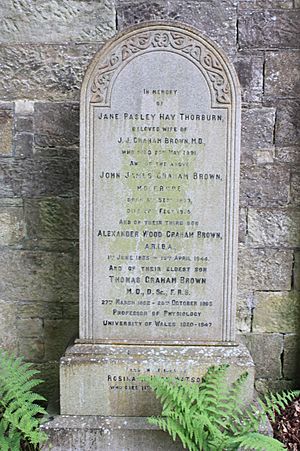Thomas Graham Brown facts for kids
Quick facts for kids
Thomas Graham Brown
|
|
|---|---|
 |
|
| Born | 27 March 1882 Edinburgh, Scotland
|
| Died | 28 October 1965 (aged 83) Edinburgh, Scotland
|
| Alma mater | University of Edinburgh |
| Awards | Fellow of the Royal Society (1927) |
| Scientific career | |
| Fields | physiologist |
Thomas Graham Brown (born March 27, 1882 – died October 28, 1965) was a Scottish scientist and a great mountaineer. He was known for finding three new climbing paths up the east side of Mont Blanc, a very famous mountain. He was also a physiologist, which means he studied how the human body works.
Contents
Life and Early Work
Thomas Graham Brown was born in Edinburgh, Scotland, in 1882. His father, Dr. John Joseph Graham Brown, was also a well-known doctor. Their family lived in a part of Edinburgh called the New Town.
Studying the Body
Thomas studied science and medicine at the University of Edinburgh. He became very interested in how our bodies move. He earned his first advanced degree in 1912. He then got another degree in 1914.
He had a new idea about how our bodies create rhythmic movements, like walking. He thought that special groups of nerve cells in the spine could work together to make these movements happen. This was a very new idea at the time.
His ideas were different from his teacher's, Sir Charles Scott Sherrington. Sherrington believed that movement came from signals sent back to the brain from our muscles. But Thomas Graham Brown showed that even without these signals, bodies could still make rhythmic movements. His work was so advanced that it was not fully understood until about 50 years later! Today, his ideas are widely accepted by scientists.
War Service and Later Career
During the First World War, Thomas Graham Brown served in the Royal Army Medical Corps. After the war, he continued his research on how the nervous system controls movement.
In 1920, he became a professor of Physiology at the University of Wales in Cardiff. In 1927, he was honored by becoming a Fellow of the Royal Society. This is a very important group for scientists.
Thomas Graham Brown passed away on October 28, 1965. He was buried in Dean Cemetery in Edinburgh.
Amazing Mountain Climbs
Thomas Graham Brown was also a very skilled mountaineer. He is most famous for his climbs on the east side of Mont Blanc, a huge mountain in the Alps. He found three new ways to climb this difficult face. These climbs were considered some of the most important new routes made by British climbers in the Alps during his time.
Famous Routes on Mont Blanc
His first new route was called the Sentinelle Rouge. He climbed it with Frank Smythe in 1927. The next year, in 1928, he and Frank Smythe climbed another new route called Route Major. These two climbs were very impressive and important in climbing history.
In 1933, he made his third new route on Mont Blanc. This one was called the Pear Buttress. He climbed it with Alexander Graven and Alfred Aufdenblatten.
From 1949 to 1953, Thomas Graham Brown was the editor of the Alpine Journal. This is a well-known magazine for climbers.
Other Expeditions
In 1935, Thomas Graham Brown was part of the first team to climb Mount Foraker in Alaska. This mountain is over 5,300 meters (about 17,400 feet) tall! He climbed with Charles Houston and Chychele Waterston.
In 1936, he joined a British and American team to climb Nanda Devi in the Indian Himalaya. While he was part of the team, only two other climbers reached the very top.
His Gifts and Legacy
Thomas Graham Brown loved mountains and books. He gave his huge collection of books about climbing and mountains to the National Library of Scotland. There were about 20,000 items in his collection!
He also left his house for the Edinburgh University Mountaineering Club. This club helps students learn about climbing. The university later sold the original house. However, they made sure the club still had a place. They named a flat in new student housing "Graham Brown House" for the club to use.



